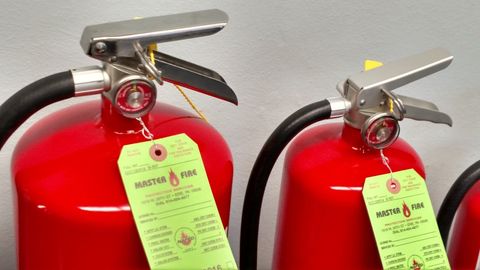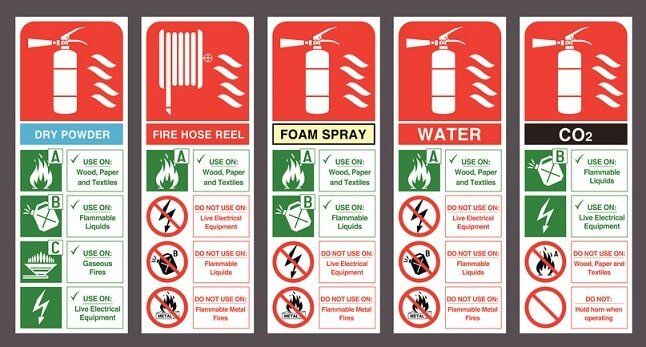DEPENDABLE FIRE EXTINGUISHERS IN ERIE, PA
How Do I Determine Which Fire Extinguisher is the Right Fire Extinguisher?


FIRE CLASSIFICATION CHART

Carbon Dioxide
Cartridge Operated Dry Chemical
Clean Agent
Dry Chemical
Dry Powder
Water & Foam
Water Mist
Wet Chemical
Carbon Dioxide fire extinguishers extinguish fire by taking away the oxygen element of the fire triangle and also by removing the heat with a very cold discharge.
Carbon dioxide can be used on Class B & C fires and are usually ineffective on Class A fires.
Cartridge Operated Dry Chemical fire extinguishers extinguish the fire primarily by interrupting the chemical reaction of the fire triangle.
Like the stored pressure dry chemical extinguishers, the multipurpose dry chemical is effective on Class A, B, and C fires. This agent also works by creating a barrier between the oxygen element and the fuel element on Class A fires.
Ordinary dry chemical is for Class B & C fires only. It is important to use the correct extinguisher for the type of fuel! Using the incorrect agent can allow the fire to re-ignite after apparently being extinguished successfully.
Halogenated or Clean Agent extinguishers include the halon agents as well as the newer and less ozone depleting halocarbon agents. They extinguish the fire by interrupting the chemical reaction and/or removing heat from the fire triangle.
Clean agent extinguishers are effective on Class A, B and C fires. Smaller sized handheld extinguishers are not large enough to obtain a 1A rating and may carry only a Class B and C rating.
Dry Chemical fire extinguishers extinguish the fire by interrupting the chemical reaction of the fire triangle.
Today's most widely used type of fire extinguisher is the multipurpose dry chemical that is effective on Class A, B, and C fires. This agent also works by creating a barrier between the oxygen element and the fuel element on Class A fires.
Ordinary dry chemical is for Class B & C fires only. It is important to use the correct extinguisher for the type of fuel! Using the incorrect agent can allow the fire to re-ignite after seemingly being extinguished.
Dry Powder extinguishers are similar to dry chemical except that they extinguish the fire by separating the fuel from the oxygen element or by removing the heat element of the fire triangle.
However, dry powder extinguishers are for Class D or combustible metal fires, only. They are ineffective on all other classes of fires.
Water and Foam fire extinguishers put out a fire by taking away the heat element of the fire triangle. Foam agents also separate the oxygen element from the other elements.
Water extinguishers are for Class A fires only and should not be used on Class B or C fires. The discharge stream could spread the flammable liquid in a Class B fire or could create a shock hazard on a Class C fire.
Water Mist extinguishers are a recent development that extinguish the fire by taking away the heat element of the fire triangle. They are an alternative to the clean agent extinguishers where contamination is a concern.
Water mist extinguishers are primarily for Class A fires, although they are safe for use on Class C fires as well.
Wet Chemical is a new agent that extinguishes the fire by removing the heat of the fire triangle and prevents re-ignition by creating a barrier between the oxygen and fuel elements.
Wet chemical of Class K extinguishers were developed for modern, high efficiency deep fat fryers in commercial cooking operations. Some may also be used on Class A fires in commercial kitchens.
- Pull the pin
- Aim the nozzle at the base of the fire from a safe distance
- Squeeze the operating lever
- Sweep the nozzle or hose from side to side


SEND US A MESSAGE
We will get back to you as soon as possible
Please try again later
BROWSE OUR WEBSITE
SEND US A MESSAGE
We will get back to you as soon as possible
Please try again later




